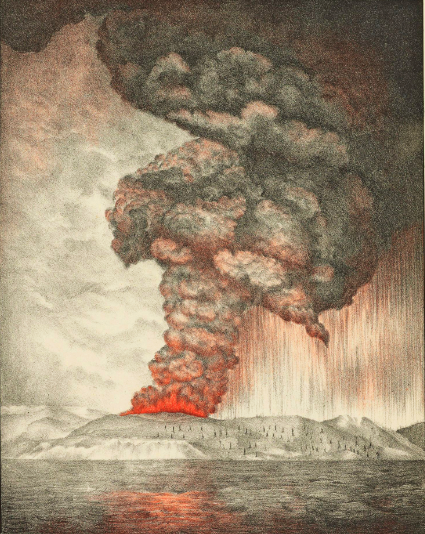Krakatoa- The stand-alone eruption
The 1883 volcanic eruption of Krakatoa in the Sunda Strait started on the evening of Sunday, 26 August 1883, and crested on the late morning of Monday, 27 August 1883. Over 70% of the island of Krakatoa and its encompassing archipelago were decimated as it collapsed into a large crater.
This volcanic eruption was one of the deadliest and most dangerous volcanic occasions in written history. Its blasts were so loud that they were heard 3,110 kms away in Perth, Western Australia, and Rodrigues close to Mauritius, 4,800 kms away. This eruption and its consequence tsunamis caused around 36,417 deaths. Huge extra impacts were additionally felt around the planet in the days and weeks after the eruption of Krakatoa liquid magma. Extra seismic movement proceeded until February 1884. Reports of seismic action after October 1883 were later excused by Rogier Verbeek's examination concerning the eruption.
Early Seismic Activities
A long time before the 1883 ejection, seismic action around the Krakatoa spring of gushing lava became exceptional, with tremors felt as distant as Australia. Starting on 19 May 1883, steam venting started to happen routinely from Perboewatan, the northernmost of the island's three cones. Emissions of debris arrived at an expected height of 20,000 ft and blasts could be heard in New Batavia (Jakarta) 160 km away.
Ejections at Krakatoa began again around 16 June, with boisterous blasts and a thick dark cloud covering the islands for five days. On 24 June, an overarching east wind cleared the cloud, and two ash sections could be seen giving from Krakatoa. The seat of the ejection is accepted to have been another vent or vents that shaped among Perboewatan and Danan. The savagery of the continuous emissions made tides in the region to be curiously high.
Eruption phases
On 27 August, four tremendous blasts happened. At 5:30 am, the primary blast was at Perboewatan. At 6:44 am, Krakatoa detonated again at Danan, with the subsequent torrent spreading toward the east and the west. The third and biggest blast at 10:02 am, was fierce to the point that it was heard 3,110 km away in Perth, Western Australia and the Indian Ocean island of Rodrigues close to Mauritius, 4,800 km away, where the impact was thought to have been gun discharge from a close-by transport. The third blast has been accounted for as the most intense sound heard in noteworthy times. The sound intensity was 180 Db. Each blast was joined by tidal waves assessed to have been more than 30 meters high. A huge region of the Sunda Strait and spots on the Sumatran coast were influenced by pyroclastic streams from the gushing lava. The energy produced from the blast was around 200 megatonnes of TNT. At 10:41 am, an avalanche removed a portion of Rakata, alongside the rest of the island toward the north of Rakata, causing the last explosion.
Effects
The mix of pyroclastic streams, volcanic debris, and tidal waves related to the Krakatoa emissions had unfortunate territorial outcomes. Some land in Banten, around 90 km south, was never repopulated; it returned to the wilderness and is presently the Ujung Kulon National Park.
After Effects
More volcanic activities led to the formation of Anak Krakatau. It erupted in 2018 causing tsunamis and killing around 427 people.
Krakatoa in the pop culture
A film Krakatoa, East of Java is based on the volcanic disaster. The 1883 explosion was also a source of inspiration for ‘The Scream’, by Edvard Munch.
For more Valuable Insights,
Check out our Site: https://wanderersthoughts.in/
Blog: https://www.arjunblog.com/
Dishi Singh





✌🏻✌🏻✌🏻
ReplyDelete😊
Delete👍👍👍
ReplyDelete✌️
DeleteGreat 👍
ReplyDeleteThank you
DeleteKeep it up .....
ReplyDeleteThank you 😊
Delete👍👍👍👍
ReplyDelete✌️
DeleteGood work 👌👌👍
ReplyDeletethank you
Delete👍👍👍
ReplyDelete✌️
DeleteNice👍👍 .
ReplyDeleteThank you☺️
Delete👌👌
ReplyDelete😊
Delete